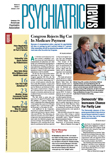In the flurry of activity that Congress undertook before its December recess, it increased the maximum number of patients for whom individual physicians can provide outpatient opioid addiction treatment with buprenorphine from 30 to 100.
Buprenorphine is the only FDA-approved, controlled medication indicated for treatment of opioid dependence that government-certified physicians may prescribe in private medical offices.
Since office-based buprenorphine treatment was first legalized in 2000, APA has lobbied hard not just to increase but to lift the limit on the number of patients that individual physicians are permitted to treat. The 30-patient limit resulted in patients being kept on waiting lists for weeks or months for the medication.
The new limit was passed in legislation (HR 6344) reauthorizing the Office of National Drug Control Policy and amends the Controlled Substances Act. It applies to Suboxone (buprenorphine HCl/naloxone HCl dihydrate) and Subutex (buprenorphine HCl).
Physicians must have prescribed the drug for a year before they are allowed to treat up to 100-patients at a time.
Eric C. Strain, M.D., chair of the APA Council on Addiction Psychiatry, noted, “This increase in the limit is an important step forward in expanding treatment capacity for opioid addiction and should be especially valuable for underserved areas where there are few physicians available to prescribe buprenorphine.”
A May 2006 survey of buprenorphine-prescribing physicians conducted by the Substance Abuse and Mental Health Services Administration (SAMHSA) and the Center for Substance Abuse Treatment found that the 30-patient cap led more than 25 percent of physicians surveyed to limit their buprenorphine prescribing to the point that they could not meet the demand for it (Psychiatric News, September 1). The survey was conducted to evaluate the prescribing program as required by the Drug Addiction Treatment Act of 2000 (DATA 2000), which first authorized office-based buprenorphine treatment.
Herbert Kleber, M.D., a member of the APA Council on Addiction Psychiatry, told Psychiatric News that buprenorphine is a critical tool to combat addiction to heroin, which afflicts about 1 million Americans, and the growth of prescription opioid addiction, estimated to afflict more than 2 million Americans.
Certifications Exceed Estimates
The number of physicians certified to prescribe buprenorphine was 9,626 by mid-December 2006, and was expected to top 10,000 by early 2007, according to SAMHSA officials. However, the agency believes that only half of the physicians certified to prescribe the medication are doing so.
The number of certified physicians exceeds initial estimates of federal officials, who thought before the program was approved that about 6,000 clinicians, or 1 percent of U.S. physicians, would participate.
Supporters of the new limit said it may encourage more physicians to offer the treatment because the higher limit would increase their experience with it and make them more comfortable treating addictions.
Kleber, director of the Division on Substance Abuse at Columbia University Medical Center and a former deputy director in the Office of National Drug Control Policy, helped to launch an opioid-addiction treatment program with the Columbia University Department of Psychiatry at New York Presbyterian Hospital, which treats about 90 patients at any given time. Large opiate-addiction treatment programs—unlike individual physicians—have not been subject to the 30-patient limit. Federal drug-enforcement officials argued for the limit because of fears that office-based treatment for opioid addiction would spur further illegal drug use. In July 2006 Congress lifted a provision of DATA 2000 that had also imposed the 30-patient limit on group treatment practices.
Detox Process Sometimes Rushed
Patients are most successfully treated when they have realigned their entire lives to support detoxification, and physicians generally“ maintain” such patients on buprenorphine while that realignment is taking place. Because that process is time consuming, said Elinore McCance-Katz, M.D., Ph.D., president-elect of the American Academy of Addiction Psychiatry, some physicians faced with patient waiting lists were tempted to hurry the detoxification process, which can endanger patients' recovery.
“People with addictions have serious psychosocial problems that require extensive counseling, as well as medical treatment,” McCance-Katz told Psychiatric News.
Edwin Salsitz, M.D., director of the addiction program at Beth Israel Medical Center in New York City, described opioid dependence and addiction as a national public health crisis.
“Office-based treatment with Suboxone is one option in the physician's arsenal, and removing restrictions around its use surely will be beneficial to patients across the country,” Salsitz said in a written statement. “And, of course, the corollary to removing unnecessary restrictions on prescribing is that more doctors need to become active in treating this under-treated and often unrecognized but life-threatening disease.”
Information on APA's online buprenorphine training course is posted at<www.psych.org/edu/bup_training.cfm>. SAMHSA provides a physician locator and other information on buprenorphine treatment at<www.buprenorphine.samhsa.gov>.▪
